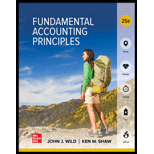
Concept explainers
Concept:
Methods of
Some of the inventory valuation methods are as follows:
FIFO: Stands for First In First Out. Under this method of inventory valuation, the costs to be assigned to ending inventories are, the costs of the goods first purchased, i.e. the company assigns the closing inventory costs at the costs of the first purchase, since the goods purchased first are assumed to be sold first.
LIFO: Stands for Last In First Out. Under this method of inventory valuation, the costs to be assigned to ending inventories are, the costs of the goods last purchased, i.e. the company assigns the closing inventory costs at the costs of the last purchase, since the goods purchased first are assumed to be sold first.
WA: Stands for Weighted Average. Under this method of inventory valuation, the costs to be assigned to ending inventories are, the weighted average costs of purchases i.e. the total costs of purchases divided by the weights of products of the purchases, since the cost of goods purchased is averaged out.
SA: Stands for Simple Average. Under this method of inventory valuation, the costs to be assigned to ending inventories are, the simple average costs of purchases i.e. the total costs of purchases divided by the number of products of the purchases, since the cost of goods purchased is averaged out.
Methods a company can use to assign costs of goods sold and ending inventory.
Want to see the full answer?
Check out a sample textbook solution
Chapter 6 Solutions
FUND.ACCT.PRIN.
- I am looking for help with this general accounting question using proper accounting standards.arrow_forwardFinancial Accounting Question Solution Please Provide Solution Without Ai and Copy past if Give Wrong Answer I give Unhelpfularrow_forwardPlease provide the correct answer to this general accounting problem using valid calculations.arrow_forward
- HELParrow_forwardCan you help me solve this accounting problem with the correct methodology?arrow_forwardEcho Industries uses a single raw material in its production process. The standard price for a unit of material is $2.25. During the month, the company purchased and used 820 units of this material at a price of $2.10 per unit. The standard quantity required per finished product is 4 units, and during the month, the company produced 205 finished units. How much was the material price variance?arrow_forward

 AccountingAccountingISBN:9781337272094Author:WARREN, Carl S., Reeve, James M., Duchac, Jonathan E.Publisher:Cengage Learning,
AccountingAccountingISBN:9781337272094Author:WARREN, Carl S., Reeve, James M., Duchac, Jonathan E.Publisher:Cengage Learning, Accounting Information SystemsAccountingISBN:9781337619202Author:Hall, James A.Publisher:Cengage Learning,
Accounting Information SystemsAccountingISBN:9781337619202Author:Hall, James A.Publisher:Cengage Learning, Horngren's Cost Accounting: A Managerial Emphasis...AccountingISBN:9780134475585Author:Srikant M. Datar, Madhav V. RajanPublisher:PEARSON
Horngren's Cost Accounting: A Managerial Emphasis...AccountingISBN:9780134475585Author:Srikant M. Datar, Madhav V. RajanPublisher:PEARSON Intermediate AccountingAccountingISBN:9781259722660Author:J. David Spiceland, Mark W. Nelson, Wayne M ThomasPublisher:McGraw-Hill Education
Intermediate AccountingAccountingISBN:9781259722660Author:J. David Spiceland, Mark W. Nelson, Wayne M ThomasPublisher:McGraw-Hill Education Financial and Managerial AccountingAccountingISBN:9781259726705Author:John J Wild, Ken W. Shaw, Barbara Chiappetta Fundamental Accounting PrinciplesPublisher:McGraw-Hill Education
Financial and Managerial AccountingAccountingISBN:9781259726705Author:John J Wild, Ken W. Shaw, Barbara Chiappetta Fundamental Accounting PrinciplesPublisher:McGraw-Hill Education





